Content Theories Of Motivation
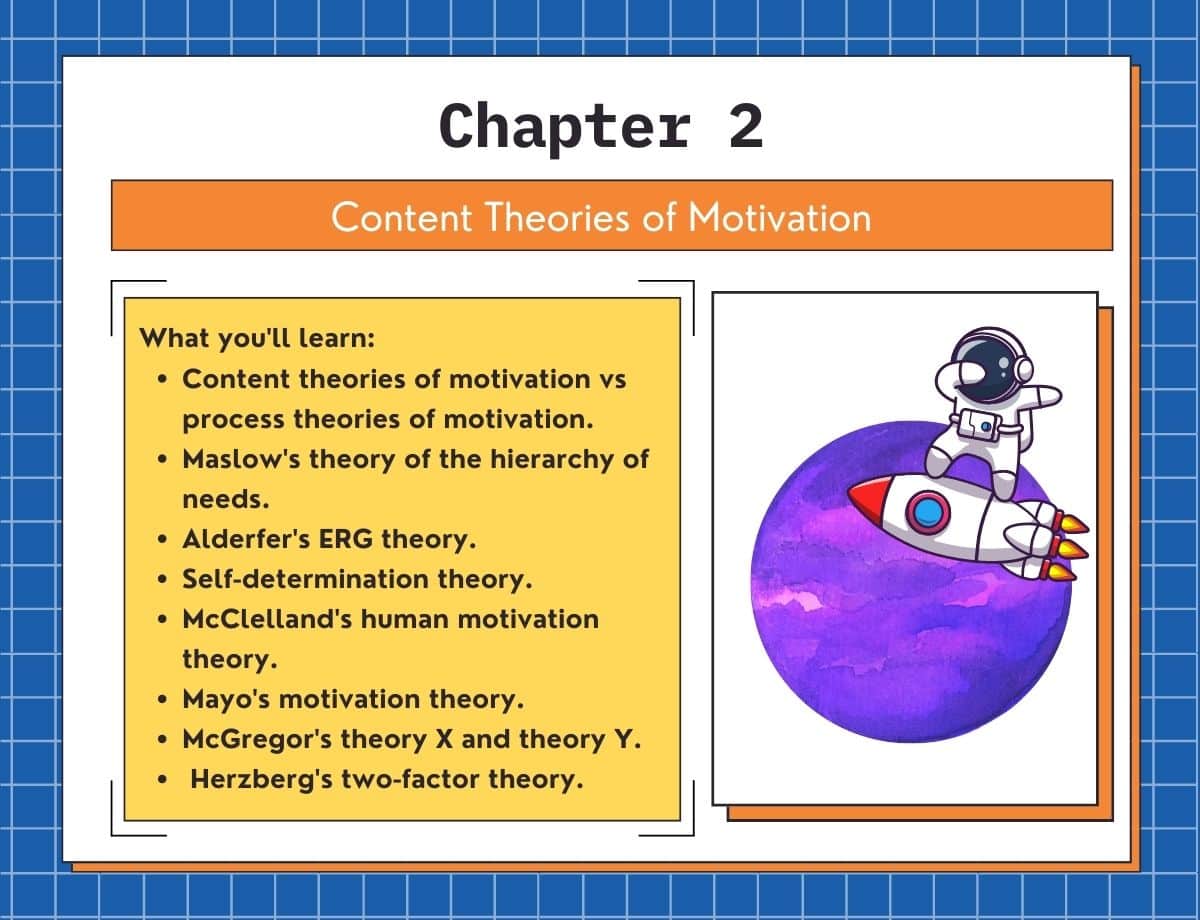
What are content theories of motivation? Do you know the 5 levels of happiness, according to Maslow? Have you heard about the ERG model, self-determination theory, and McClelland’s human motivation theory? No? Perfect. In Chapter 2 of the Beginner’s Gamification Guide, you’ll learn the main content theories of motivation. Let’s discover together where human motivation comes from!

Chapters
You are in Chapter 2 of the Beginner’s Gamification Guide.
Some mornings are a struggle. One day you’re ready and raring to go and the next you need toothpicks to hold your eyes open. These different levels of motivation are something we can all relate to. And, as you learned in the last chapter, motivation is what gamification is looking to drive.
You can’t just slap gamification on something and expect it to create the behaviour you want. The way you encourage buyers to buy may not be the same as engaging learners in your training course or encouraging your sales teams to reach their quotas. Investing in gamification and assuming it will always work simply because you’ve got loyalty points is the wrong expectation. Gamification is more than leaderboards, experience points, and rewards. Behind gamification, there’s a particular motivation related to a human need.
So, today we’ll look at theories of motivation and how these drivers push us to reach our goals. Then we’ll talk about how to apply them to gamification which you learned about in the Chapter 1 – Gamification Definition.
Content. Process. What’s the difference between these two theories of motivation? Well, one is a theory about what motivation is, and the other explains how it works.
Both theories of motivation seek to explain why and how we do what we do.
Content theories of motivation define our motives and needs that drive our behaviour, and process theories of motivation show us what we might do to meet those needs. You can learn more about both here.
First, we will explore the content theories of motivation to give you a framework for the why of our motivations.

Content theories of motivation – what motivates people?
Who was Abraham Maslow?
Abraham Maslow was an American psychologist and humanist who created one of the most popular theories of motivation: the Hierarchy of Needs.
His human-centric approach to psychology postulated that, at the core, humans all want to self-actualise or fulfil their potential. He also believed that this is impossible to achieve until other fundamental needs are reached.
What is Maslow’s theory of hierarchy needs?
Based on his humanist philosophy, the ultimate goal of all people is to be the best they can be. But, to do that, all needs for food, safety, social connection, and self-esteem must be met. Once all these needs are met, one can reach their full potential and be self-actualised. We’ll dig into those 5 different levels of happiness next. Remember, to become one’s best, all the bottom needs must be achieved.
The 5 levels of happiness
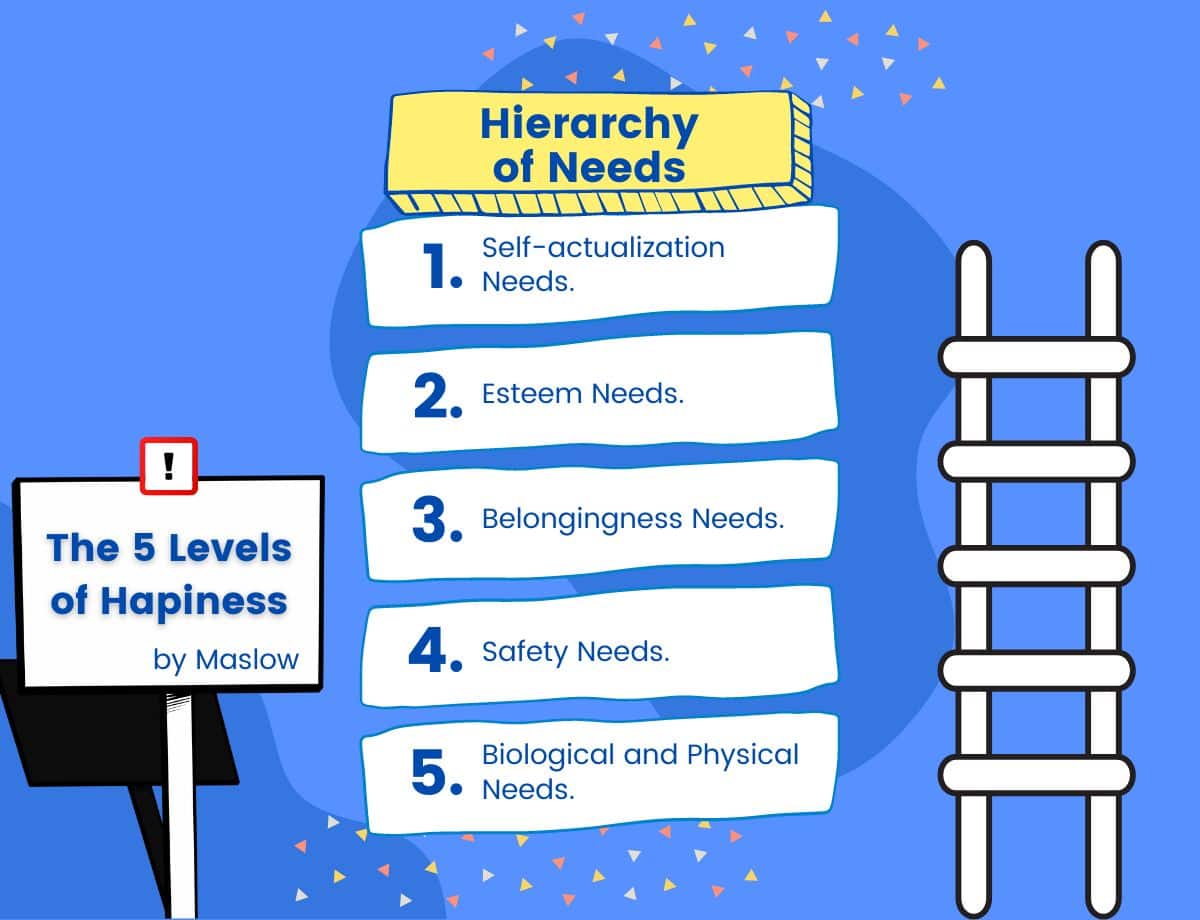
1. Physiological Needs
First and foremost, you need some basic things to survive. Food, water, air, warmth and reproduction. Modern humans need a home and clothes too. Before any of the higher needs can be met, physiological needs must be attended to.
2. Security and Safety Needs
After that, you’re looking after your safety and security. This isn’t just protection from accidents and injury- although that’s part of it – these are the need for health, wellness and money security. When paired with physical needs, these are our two most basic motivators. It’s why we put money in savings and try to get (and keep) a good job.
3. Social Needs
Belonging, acceptance and love; are the family, friends, community & social groups, lovers and religious gatherings that add meaning to our lives. This is an emotionally driven need that helps to stave off depression, loneliness and anxiety. Everything we do to enrich ourselves through time with others will fall into this category.
4. Esteem Needs
Next, we have our desire to be respected and appreciated. If we have food, shelter, friends and the other more basic needs covered, this need takes over. We begin to look forward to making accomplishments that others notice, and when we do, we feel better about ourselves and our worth. How we do this could vary greatly.
Sports, philanthropy, academics, career awards and more all contribute to the fulfilment of esteem and stave off inferiority complexes. Within Maslow’s theories of motivation, esteem combines with social needs to tick off our physiological requirements as human beings.
5. Self-Actualization Needs
Then, as we mentioned before, self-actualisation is at the top. This is where what others think matters much less, and you’re focused on personal growth. You’re becoming self-actualised when you’re using all your talents to the best of your ability and living up to your potential.
Remember, you must meet all your physiological and psychological needs before reaching this last peak.
Maslow’s theories of motivation expanded.
In the 1970s, the five stages were supplemented with two further stages, which looked after our aesthetic and cognitive needs. When we fulfil our cognitive needs, we learn and expand our knowledge generally and specifically on topics of interest.
And when we look after our aesthetic requirements, we seek balance, harmony and beauty in our lives and surroundings. Adding these two additional needs pushed our self-actualisation to the top above cognitive and aesthetic needs within Maslow’s theories of motivation.
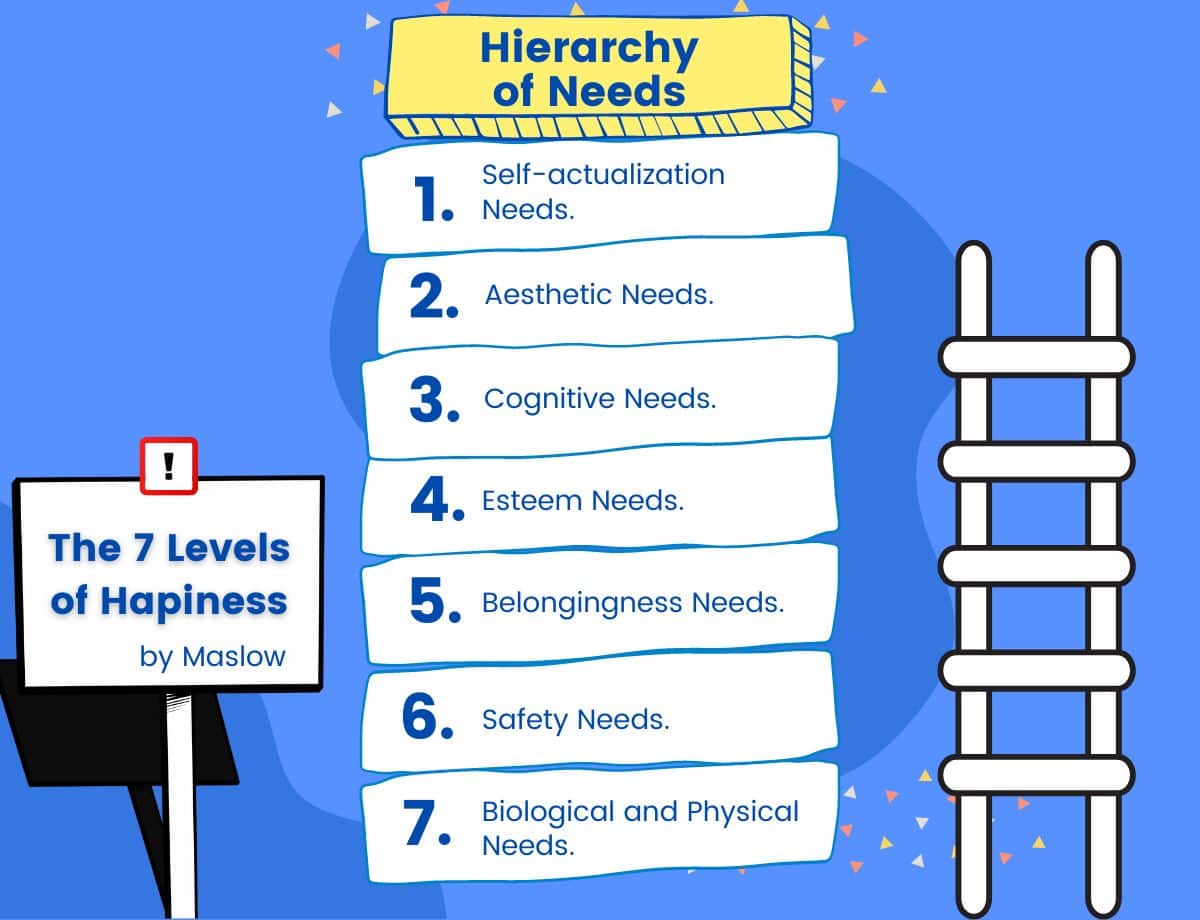
Who was Clayton Alderfer?
Another American psychologist, Clayton Alderfer further developed Maslow’s theories of motivation into his own theory based on 3 groups of core needs – shortened to ERG. These are existence, relatedness and growth. We’ll explore this evolution of Maslow’s theory in more detail below.
What is Alderfer’s ERG theory?
Inspired by Maslow’s theories of motivation, the ERG theory is an evolution that postulates humans must achieve groups of core needs. Alderfer believed all human needs are within existence, relatedness and growth. And while they might be at different levels for different people or fluctuate over time, they’re critical to human happiness.
Another one of our content theories of motivation, the ERG model is famous for its simplicity. The first and most critical need is for psychological and physical survival. The next is to build a sense of community and a healthy sense of self. Then, you can move towards fulfilling your potential and being all you can be.
How the model works
Alderfer’s ERG model differs from Maslow’s theories of motivation because Alderfer believed you could motivate and work towards multiple needs simultaneously. He also didn’t think you needed to fully satiate one need before moving to the next. Rather, he explained that human motivations are more fluid and one need may take priority over another at different times in our lives. Also, we can see these ERG levels increase and decrease over time.
Comparing Alderfer and Maslow
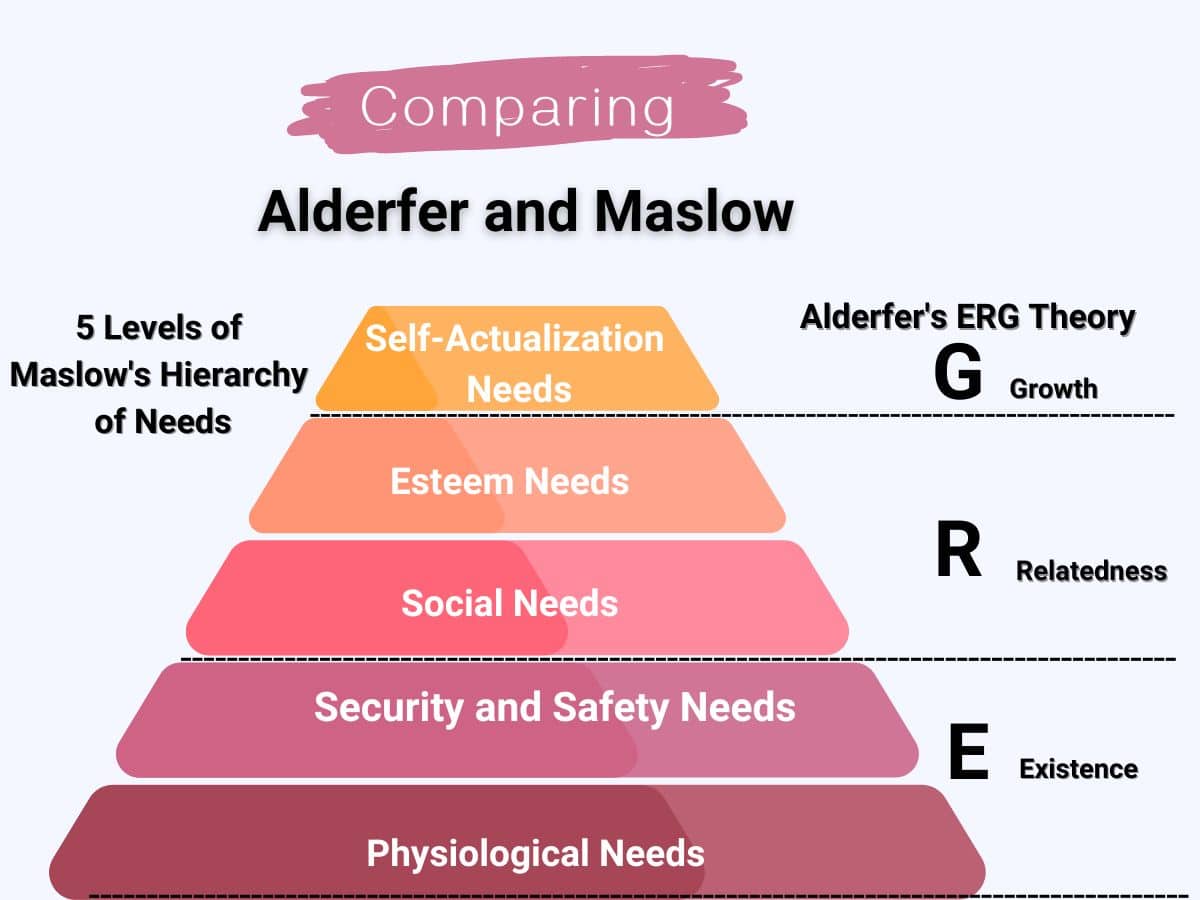
If you remember, within Maslow’s theories of motivation, you couldn’t move on to the upper tiers until you had the lower tiers completed. Alderfer would disagree. He believed you could learn and grow towards self-actualisation while working a part-time job to meet your basic safety and physical needs.
He famously gives the example of the starving artist giving up basic comforts for their art. Plus, he noted that humans may see their needs as fulfilled when others might not, even if they have more. Or how feeling like progress is being made is a strong motivator, while feelings of futility are demotivating.
If you think you’re not making social connections, you might put your effort elsewhere into learning a new skill.
The ERG model in the world of work
As a result of these theories of motivation, we now believe our needs are more balanced than Maslow’s postulated. And that’s a good thing.
It means we don’t need to ensure our team members have satisfied their basic needs before helping them self-actualise or build relationships. When we apply this to gamification, we’re looking to add a range of motivators across the whole ERG spectrum.
If Alderfer is correct, this will provide a more significant driver towards the actions we want by allowing our teams to satisfy the needs that appeal to them most. Maybe they might even want to strive towards a few blended needs. Lastly, we should – as leaders- expect these needs to change over time and, therefore encourage our teams to seek a ‘pick and mix’ of motivations.
Who was Richard Ryan and Edward Deci?
Richard Ryan and Edward Deci were psychologists at the University of Rochester who were fascinated with theories of motivation and destined to make a significant impact on their field. For 30 years, they’ve developed and evolved self-determination theory (SDT) into a powerful predictor of human behaviours.
What is self-determination theory (SDT)?
In short, SDT proposed that people improve and change themselves because of innate needs. For people to be self-determined, they need to have their connection, competence and autonomy needs fulfilled.
If you’ve heard about intrinsic motivation, that’s a big player in SDT. In their 1985 book “Self-Determination and Intrinsic Motivation in Human Behaviour”, Deci and Ryan introduce one of the more modern theories of motivation that state people are driven internally by a need to grow. This is based on two core ideas:
- Desiring growth fuels behaviours.
- People need to feel autonomy, competence and connection to get to that growth.
Extrinsic and Intrinsic motivation
Intrinsic motivation is internal drivers like the need to know more and be independent. External motivators are things like titles, money and awards. With SDT’s theories of motivation people are more driven by internal motivators than external ones in the pursuit of self-determination. So, the core motivators in SDT are intrinsic rather than extrinsic. These are grouped into:
- Autonomy – feeling in control and able to make real change happen
- Competence – getting good at different skills and tasks to where you feel more confident to take on new challenges
- Connection – feeling attached to other people and having a place where you belong.
If you have high self-determination and fail during a work task, you would feel comfortable taking responsibility, brainstorming solutions and taking action. But if you’re low on self-determination, you might blame others, refuse to take further action and wallow in helplessness.
Who was David McClelland?
This American Harvard psychologist was praised for his work on Need Theory. His many publications between 1950 and 1990 worked to further theories of motivation and improve scoring for the TAT and other similar tests. His 1961 book “The Achieving Society” focuses on 3 human motivators: power, achievement and affiliation. And he argued that different people have one need that is often more dominant than the others.
What is McClelland’s human motivation theory?
McClelland’s human motivation theory argued that the 3 dominant needs of power, achievement and affiliation drive all human action.
While some may be higher than others, depending on where you come from and your values, they are all omnipresent. Unlike some other theories of motivation, he argued that only one of these factors is active at any one time and that intrinsic and extrinsic motivation cause power, achievement and affiliation to manifest.
Following on from these theories of motivation, McClelland argued that companies should decide who to hire based on a track record of success within a given field. This flew in the face of the IQ and personality tests that were becoming popular in the 70s, 80s and 90s. His arguments were so popular that they’re now standard practice for interview questioning techniques.
Who was George Elton Mayo?
George Elton Mayo was an Australian psychologist who revolutionised industrial sociology in the USA. His focus on small groups, unification and its impact on productivity are common models for leadership training today. Lastly, he was a major contributor to the Human Relations Movement as a Harvard Business School professor.
What is Mayo’s motivation theory?
Based on data from the Hawthorne Studies, Mayo created one of the most popular theories of motivation that stuck off pay and environment as major factors. He argued that social relationships were even more important and that group work which is effective and productive is the largest determiner of success. Mayo discussed that the group will self-regulate. Too slow and you’re out. Same if you’re too fast (no one likes a know it all). You can see how this theory works with a simple chart:
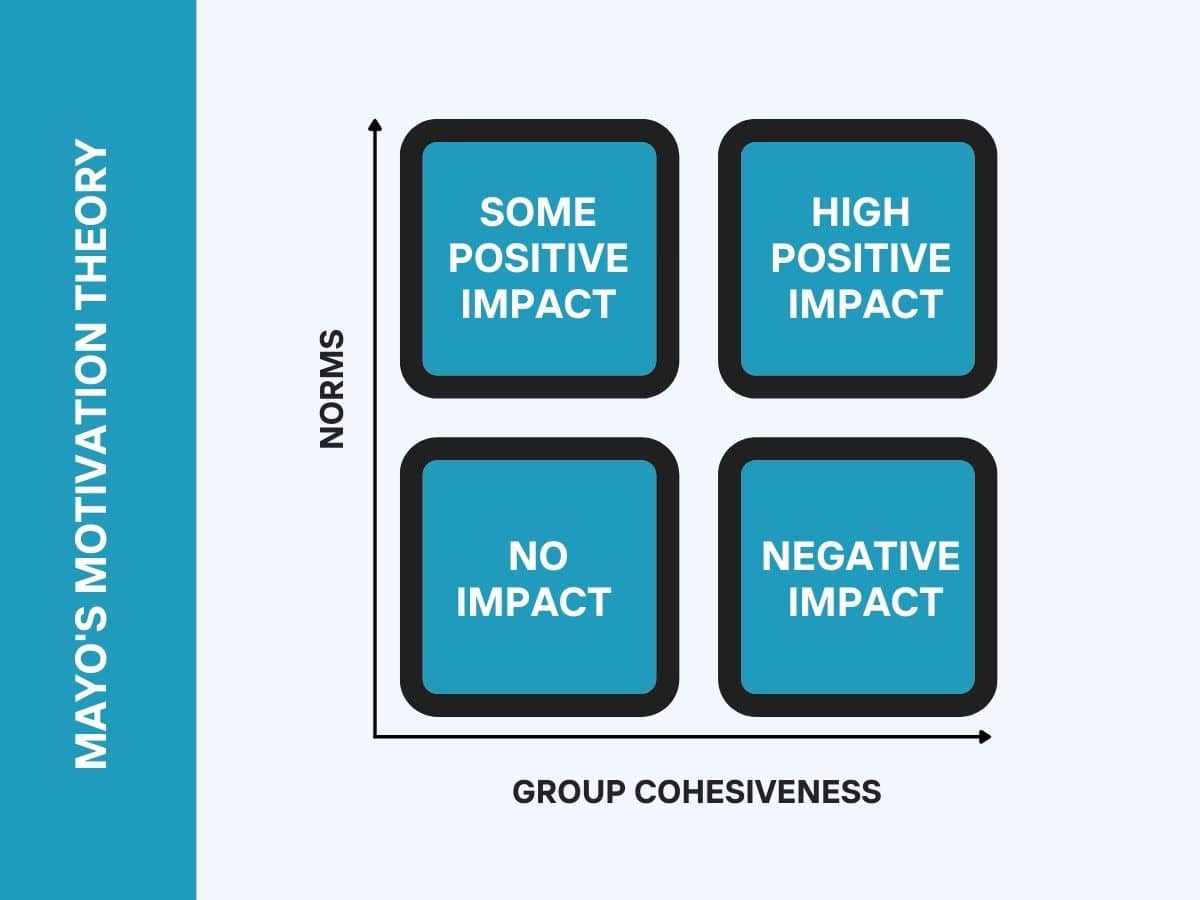
Group cohesiveness is that working togetherness. It’s the comradery and social norms which fuel good or bad behaviour. Here are how the positions work:
- Low cohesiveness and low norms – useless for productivity and lacking any motivation
- High cohesiveness and low norms – they get along great but do bad things, think street gangs
- High norms but low cohesiveness – this is all about the individual and productivity is stunted
- High norms and high cohesiveness – this is the best-case scenario where teams support each other to reach high levels of productivity
Using Mayo’s Model
Start with strong communication that’s regular and contains useful feedback. Then get people working together. If you have a large team, break it into small groups. Reward the groups based on their achievements and cohesion. Finally, get yourself involved.
Ask social questions and try to get to know the person. Don’t overdo it. Autonomy is essential too but in the Hawthorne studies, people responded well to all three of these approaches in tandem. Overall satisfaction and productivity went up.
We’ll explain the Hawthorne Experiments and the Philadelphia Spinning Mill Studies, which contributed to Mayo’s theories of motivation, in more detail below:
The Philadelphia Spinning Mill Studies
Mayo wanted to have an impact on the industrial unrest in Australia. He felt that workers needed to feel valued and part of a group to have the right conditions for effective work. And Mayo felt this was a management issue. The Philadelphia Spinning Mill sought him to reduce the turnover rate from 250% to the 6% department average.
So, Mayo changed the conditions to better align with his morale strategy. He changed the rest periods to allow for incremental improvements to productivity and rolled out other changes that reduced the turnover rate to an average in just a year. After that, his fame allowed him to improve on his theories of motivation and make an impact on Management Theory.
The Hawthorne Experiments
As we touched on, the Hawthorne experiments put his theories of motivation to the test. Following the mill project, Mayo went to Western Electric Company’s Hawthorne Works in Cicero, Illinois. His goal was to increase loyalty and reduce turnover & unions without damaging the public image of the company.
They had started with improving lighting conditions, then rest periods and differing working hours. But the company wasn’t sure what was having an impact, so Mayo stepped in. The discoveries showed that productivity increased due to forming a positive-impact team and that group formation made the workers happier to participate and more satisfied with their jobs.
Next, they made more discoveries during interviews about the employee’s home life and work attitudes. In nondirected talks, Mayo and his team gathered hours of data on the workers as humans. They noted how important participatory and supporting leaders were to them and how social cohesion and interpersonal relations formed a huge part of their working lives. They used this to train leaders and adjust policies.
Eventually, they learned even more from the “Bank Wiring Room Study.” Here, they took employees with bad behaviour like slowdowns, physical fights and cliques and put them in a group with productive employees.
They wanted to know where the poor behaviour came from. They saw little groups form over time, and behaviours get regulated for good or ill within those groups. So, if management adjusted for that, productivity could improve.
While the studies ended in 1933, the Great Depression kept the work under wraps for nearly 30 years! Thankfully, when the studies did come out, Mayo had highlighted the value of Human Relations to such a degree the world had to take notice. He showed how satisfaction, leadership, participation, norms and change are all ruled by effective micro-groups. This kickstarted the study of Organisational Behaviour and Organisational Psychology.
The famous Hawthorne Effect
During the studies, the Hawthorne Effect was identified. This idea states that we act better when we think we’re being watched. Just having someone monitoring us changes our behaviour. Overall, they used this effect to explain why productivity improved with the lighting and other early changes and why. It was simply because they were being studied. This effect along with Mayo’s theories of motivation has a huge impact on HR today.
Who was Douglas McGregor?
Douglas McGregor was a social psychologist and professor at MIT Sloan’s management school. He was a student and close friend of Abraham Maslow, perhaps leading him to develop his theories of motivation. In his book, “The Human Side of Enterprise,” McGregor introduces two opposing ideas. He postulates that a manager’s own beliefs on theories of motivation and their attitudes towards their team impact their leadership style.
What are McGregor’s theory X and theory Y?
McGregor’s theory X and theory Y are conflicting approaches to management and theories of motivation. Developed in the 60s, they’re still impactful and commonplace today. Theory X is an authoritarian style and Theory Y is participative. If you think people are lazy and hate their jobs, you’ll lean towards Theory X. You’ll micromanage people and tell them what to do. But if you think people enjoy doing good work and like challenging themselves, you’ll opt for Theory Y. In this participatory style, you’ll trust people to do a good job and lead by example.
Depending on what you choose, you’ll either have a motivated, high-performing team or a demotivated one. In McGregor’s theories of motivation, the focus is on the manager and their beliefs and biases. Overall, it puts team success within their sphere of influence. Let’s delve into it a bit more:
Theory X
With Theory X, you’re looking pessimistically at your team. You think the worst of your employees – that they are lazy and don’t want to work. Managers like these are prevalent in repetitive jobs like factory or line work. And you’ll hear the words ‘carrot’ and ‘stick’ bandied around quite a bit. Performance action plans and pay rises are all tied to quantitative metrics like output and sales while poor performers are (often publicly) reprimanded. Lastly, there’s a sense of overbearing monitoring. Remember, in this style, managers think workers don’t like their jobs, need constant direction, won’t deliver work without being forced to, don’t like responsibility, need micromanagement and don’t have any internal motivation – so they need rewards to meet targets.
You’ll know you’re in an organisation like this if you have many levels of management with limited delegation and central control over operations. For modern offices and companies, this approach is no longer popular. However, huge operations with thousands of employees might fall back on this style to meet quotas.
Theory Y
Theory Y is a more optimistic approach. HBR explains, “Theory Y—the integration of goals—emphasises the average person’s intrinsic interest in his work, his desire to be self-directing and to seek responsibility, and his capacity to be creative in solving business problems.” So, managers in this style can opt for a decentralised and delegation-based approach. This management style allows for collaboration, trust and productive relationships to form between team members and managers.
Because people are encouraged to own their tasks and self-improvement, appraisals are not assessments, but rather the chance to have a dialogue. They’re not a form of control or Big Brother-like they might be in other theories of motivation. Lastly, these environments provide a lot of options for growth and promotion. That’s because managers in Theory Y believe largely that workers have internal motivators, should direct decisions, can work unsupervised, love taking ownership of what they do, need a little direction and want to challenge themselves.
In this environment, you’ll see greater levels of creativity and imagination. Maybe that’s why it’s so popular in the modern world of work. Today’s workers want important careers that provide them with more than a salary.
Who was Frederick Irving Herzberg?
Frederick Irving Herzberg was an American psychologist who created theories of motivation and business management including the Motivator-Hygiene theory and the job enrichment approach. In his 1968 publication, “One More Time, How Do You Motivate Employees?”, he talks about making jobs more interesting and this work is still cited often today.
What is Herzberg’s two-factor theory?
In these dual theories of motivation, Herzberg contrasts job satisfaction with job dissatisfaction. Motivators make employees work harder, and hygiene demotivates workers if they are not present. From what became the most asked-for article in the Harvard Business Review, Herzberg’s theories of motivation focused on the different impacts of these two factors on employee performance.
With hygiene in place, you’re happy but not motivated to push any harder than you have to. And if you feel something is out of place, you’ll become demotivated. Oh, and if you see someone acting out, chances are their hygiene needs are not fulfilled. But what are these hygiene factors? Let’s explore.
Hygiene factors
We all have basic needs when it comes to working. And hygiene factors are those needs. Think of pay, fairness, security, good working conditions and the like. While they won’t make you work harder, they are basic requirements that -without them- cause you to become unhappy in your job fairly quickly. Here are a few examples:
- Pay and package: If you’re well paid, you’re more content.
- Security: How likely are you to be laid off or fired?
- Environment: How nice is the office, commute and stress during work?
- Reputation: What do people think of your company?
- Policies: Are you treated fairly?
- Management: How much freedom and autonomy do you have?
Herzberg motivators
Now, the above will just keep you content. They won’t make you go above and beyond. For that, you need motivational factors. These are the elements and theories of motivation managers can employ to get people excited about their work. It’s how you can push people to take on more challenges, grow professionally, enrich themselves and take on more responsibility.
Here are a few examples:
- Status: How authoritative are you seen at your job?
- Social: How much do you enjoy client and team relationships?
- Achievement: Do you enjoy completing tasks?
- Recognition: Are you thanked when you go above and beyond in some way?
- Development: Are you able to learn new skills and grow?
- Completion: Can you finish tasks on time?
- Interest: Do you find your work stimulating?
- Responsibility: Can you take on more duties and gain authority?
- Advancement: Can you earn a promotion?
- Creativity: Do you have the freedom to brainstorm and implement ideas?
- Autonomy: Can you decide what to do for yourself?
- Variety: Is the work different and not the same old, same old?
The four states
Organisations can exist in four states:
- High Hygiene and High Motivation – In this workplace, all workers are motivated and happy. Performance and turnover are both good.
- High Hygiene and Low Motivation – Here, workers are happy but only clock in and clock out. They’re not motivated. The results are probably low.
- Low Hygiene and High Motivation – In this office, people want to go above and beyond but the conditions are bad. Turnover is probably high.
- Low Hygiene and Low Motivation – This is the worst-case scenario. There are lots of grievances and bad performance is rife.
If you want to read about more theories of motivation, we’re including a list below. These are cognitive drivers that influence, express or explain why we do certain behaviours and how those drivers are influenced. It’s good to remember that theories of motivation are complex and nuanced – you might find a combination of factors holds true for your workplace. To explore more, consider reading up on:
- Dissonance (Festinger, 1957; Harmon-Jones & Mills, 1999)
- Reactance theory (Brehm, 1966)
- Learned helplessness theory (Miller & Seligman, 1975)
- Self-concept (Markus, 1977)
- Mastery beliefs (Diener & Dweck, 1978)
- Self-efficacy (Bandura, 1986)
- Attributions (Wiener, 1986)
- Deliberative versus implementation mindsets (Gollwitzer & Kinney, 1989)
- Perceived control (Skinner, 1996)
- Promotion versus prevention orientations (Higgins, 1997)
- Plans (Carver, Scheier, & Weintraub, 1998)
- Implementation intentions (Gollwitzer, 1999)
- Self-regulation (Zimmerman, 2000)
- Goals (Locke & Latham, 2002)
- Values (Eccles & Wigfield, 2002)
- Growth versus fixed mindsets (Dweck, 2006)
- Possible selves (Oyserman, Bybee, & Terry, 2006)
- Identity (Eccles, 2009)
- Self-control (Baumeister & Tierney, 2011)